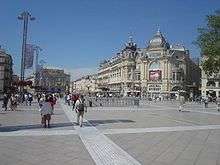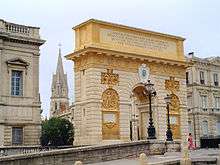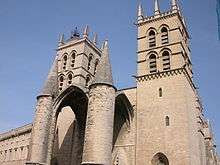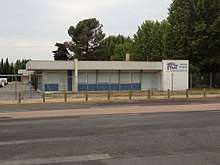Montpellier
Montpellier (UK: /mɒntˈpɛlieɪ/, US: /ˌmoʊnpɛlˈjeɪ/, French: [mɔ̃pəlje, -pɛl-] (![]()
Montpellier | |
|---|---|
Prefecture and commune | |
 .jpg) .jpg) 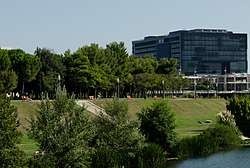 Clockwise from top: The Place de la Comédie, Port Marianne's lake, Lez's bank with the Montpellier Town Hall, and the Cathedral of Saint Peter. | |
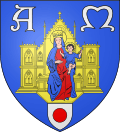 Coat of arms | |
Location of Montpellier 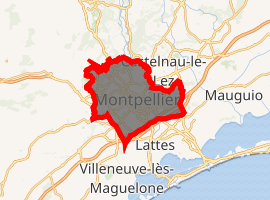
| |
 Montpellier  Montpellier | |
| Coordinates: 43°36′43″N 3°52′38″E | |
| Country | France |
| Region | Occitanie |
| Department | Hérault |
| Arrondissement | Montpellier |
| Canton | Montpellier-1, 2, 3, 4, 5 and Montpellier – Castelnau-le-Lez |
| Intercommunality | Montpellier Méditerranée Métropole |
| Government | |
| • Mayor (2014–2020) | Philippe Saurel |
| Area 1 | 56.88 km2 (21.96 sq mi) |
| Population (2017-01-01)[1] | 285,121 |
| • Rank | 7th in France |
| • Density | 5,000/km2 (13,000/sq mi) |
| • Metro | 607,896 |
| Demonym(s) | Montpelliérains |
| Time zone | UTC+01:00 (CET) |
| • Summer (DST) | UTC+02:00 (CEST) |
| INSEE/Postal code | 34172 /34000, 34070, 34080, 34090 |
| Elevation | 7–121 m (23–397 ft) (avg. 27 m or 89 ft) |
| 1 French Land Register data, which excludes lakes, ponds, glaciers > 1 km2 (0.386 sq mi or 247 acres) and river estuaries. | |
Status
Montpellier is the third-largest French city on the Mediterranean coast after Marseille and Nice. It is the 7th-largest city of France, and is also the fastest-growing city in the country over the past 25 years.
History

Medieval period
In the Early Middle Ages, the nearby episcopal town of Maguelone was the major settlement in the area, but raids by pirates encouraged settlement a little further inland. Montpellier, first mentioned in a document of 985, was founded under a local feudal dynasty, the Guilhem, who combined two hamlets and built a castle and walls around the united settlement. The name is from medieval Latin mons pislerius, referring to the woad used for dyeing locally. The two surviving towers of the city walls, the Tour des Pins and the Tour de la Babotte, were built later, around the year 1200. Montpellier came to prominence in the 12th century—as a trading centre, with trading links across the Mediterranean world, and a rich Jewish cultural life that flourished within traditions of tolerance of Muslims, Jews and Cathars—and later of its Protestants. William VIII of Montpellier gave freedom for all to teach medicine in Montpellier in 1180. The city's faculties of law and medicine were established in 1220 by Cardinal Conrad of Urach, legate of Pope Honorius III; the medicine faculty has, over the centuries, been one of the major centres for the teaching of medicine in Europe. This era marked the high point of Montpellier's prominence. The city became a possession of the Kings of Aragon in 1204 by the marriage of Peter II of Aragon with Marie of Montpellier, who was given the city and its dependencies as part of her dowry.
Montpellier gained a charter in 1204 when Peter and Marie confirmed the city's traditional freedoms and granted the city the right to choose twelve governing consuls annually. Under the Kings of Aragon, Montpellier became a very important city, a major economic centre and the primary centre for the spice trade in the Kingdom of France. It was the second or third most important city of France at that time, with some 40,000 inhabitants before the Black Death. Montpellier remained a possession of the crown of Aragon until it passed to James III of Majorca, who sold the city to the French king Philip VI in 1349, to raise funds for his ongoing struggle with Peter IV of Aragon. In the 14th century, Pope Urban VIII gave Montpellier a new monastery dedicated to Saint Peter, noteworthy for the very unusual porch of its chapel, supported by two high, somewhat rocket-like towers. With its importance steadily increasing, the city finally gained a bishop, who moved from Maguelone in 1536, and the huge monastery chapel became a cathedral. In 1432, Jacques Cœur established himself in the city and it became an important economic centre, until 1481 when Marseilles overshadowed it in this role.
From the middle of the 14th century until the French Revolution (1789), Montpellier was part of the province of Languedoc.
After the Reformation
At the time of the Reformation in the 16th century, many of the inhabitants of Montpellier became Protestants (or Huguenots as they were known in France) and the city became a stronghold of Protestant resistance to the Catholic French crown. In 1622, King Louis XIII besieged the city which surrendered after a two-month siege (Siege of Montpellier), afterwards building the Citadel of Montpellier to secure it. Louis XIV made Montpellier capital of Bas Languedoc, and the town started to embellish itself, by building the Promenade du Peyrou, the Esplanade and a large number of houses in the historic centre. After the French Revolution, the city became the capital of the much smaller Hérault.
Modern history
1.JL.jpg)
During the 19th century the city thrived on the wine culture that it was able to produce due to the abundance of sun throughout the year. The wine consumption in France allowed Montpellier's citizens to become very wealthy until in the 1890s a fungal disease had spread amongst the vineyards and the people were no longer able to grow the grapes needed for wine.[6] After this the city had grown because it welcomed immigrants from Algeria and other parts of northern Africa after Algeria's independence from France. In the 21st century Montpellier is between France's number 7th and 8th largest city. The city had another influx in population more recently, largely due to the student population, who make up about one-third of Montpellier's population. The school of medicine kickstarted the city's thriving university culture,[7] though many other universities have been well established there. The coastal city also has such developments as the Corum and the Antigone that have attracted an increasing number of students.
Lords of Montpellier
- William I of Montpellier (died 1019)
- William II of Montpellier (died 1025)
- William III of Montpellier (died 1058)
- William IV of Montpellier (died 1068)
- William V of Montpellier (died 1121)
- William VI of Montpellier (died 1149)
- William VII of Montpellier (died 1179)
- William VIII of Montpellier (died 1202)
- Marie of Montpellier (died 1213)
- and King Peter II of Aragon (died 1213)
- James I of Aragon (died 1276)
- James II of Majorca (died 1311)
- Sancho of Majorca (died 1324)
- James III of Majorca (died 1349)
Geography
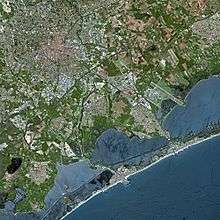
The city is situated on hilly ground 10 km (6 mi) inland from the Mediterranean coast, on the River Lez. The name of the city, which was originally Monspessulanus, is said to have stood for mont pelé (the naked hill, because the vegetation was poor), or le mont de la colline (the mount of the hill)
Montpellier is located 170 km (106 mi) from Marseille, 242 km (150 mi) from Toulouse, and 748 km (465 mi) from Paris.
Montpellier's highest point is the Place du Peyrou, at an altitude of 57 m (187 ft). The city is built on two hills, Montpellier and Montpelliéret, thus some of its streets have great differences of altitude. Some of its streets are also very narrow and old, which gives it a more intimate feel.
Climate
Montpellier has a Mediterranean climate (Köppen Csa), with mild, damp winters, and hot, rather dry summers. The monthly mean ranges from 7.2 °C (45.0 °F) in January to 24.1 °C (75.4 °F) in July. Precipitation is around 630 millimetres (24.8 in), and is greatest in fall and winter, but not absent in summer, either. Extreme temperatures have ranged from −17.8 °C (−0.04 °F) recorded on 5 February 1963 and up to 43.5 °C (110.3 °F) on 28 June 2019.
| Climate data for Montpellier (MPL), elevation: 1 m (3 ft), 1981–2010 normals, extremes 1946–present | |||||||||||||
|---|---|---|---|---|---|---|---|---|---|---|---|---|---|
| Month | Jan | Feb | Mar | Apr | May | Jun | Jul | Aug | Sep | Oct | Nov | Dec | Year |
| Record high °C (°F) | 21.2 (70.2) |
23.6 (74.5) |
27.4 (81.3) |
30.4 (86.7) |
35.1 (95.2) |
43.5 (110.3) |
37.5 (99.5) |
37.7 (99.9) |
36.3 (97.3) |
31.8 (89.2) |
27.1 (80.8) |
22.0 (71.6) |
43.5 (110.3) |
| Average high °C (°F) | 11.6 (52.9) |
12.8 (55.0) |
15.9 (60.6) |
18.2 (64.8) |
22.0 (71.6) |
26.4 (79.5) |
29.3 (84.7) |
28.9 (84.0) |
25.0 (77.0) |
20.5 (68.9) |
15.3 (59.5) |
12.2 (54.0) |
19.9 (67.8) |
| Daily mean °C (°F) | 7.2 (45.0) |
8.0 (46.4) |
10.9 (51.6) |
13.4 (56.1) |
17.2 (63.0) |
21.2 (70.2) |
24.1 (75.4) |
23.7 (74.7) |
20.0 (68.0) |
16.2 (61.2) |
11.1 (52.0) |
7.9 (46.2) |
15.1 (59.2) |
| Average low °C (°F) | 2.8 (37.0) |
3.3 (37.9) |
5.9 (42.6) |
8.7 (47.7) |
12.5 (54.5) |
16.0 (60.8) |
18.9 (66.0) |
18.5 (65.3) |
15.0 (59.0) |
11.9 (53.4) |
6.8 (44.2) |
3.7 (38.7) |
10.4 (50.7) |
| Record low °C (°F) | −15.0 (5.0) |
−17.8 (0.0) |
−9.6 (14.7) |
−1.7 (28.9) |
0.6 (33.1) |
5.4 (41.7) |
8.4 (47.1) |
8.2 (46.8) |
3.8 (38.8) |
−0.7 (30.7) |
−5.0 (23.0) |
−12.4 (9.7) |
−17.8 (0.0) |
| Average precipitation mm (inches) | 55.6 (2.19) |
51.8 (2.04) |
34.3 (1.35) |
55.5 (2.19) |
42.7 (1.68) |
27.8 (1.09) |
16.4 (0.65) |
34.4 (1.35) |
80.3 (3.16) |
96.8 (3.81) |
66.8 (2.63) |
66.7 (2.63) |
629.1 (24.77) |
| Average precipitation days (≥ 1.0 mm) | 5.5 | 4.4 | 4.7 | 5.7 | 4.9 | 3.6 | 2.4 | 3.6 | 4.6 | 6.8 | 6.1 | 5.6 | 57.8 |
| Average snowy days | 0.6 | 0.7 | 0.3 | 0.0 | 0.0 | 0.0 | 0.0 | 0.0 | 0.0 | 0.0 | 0.1 | 0.7 | 2.4 |
| Average relative humidity (%) | 75 | 73 | 68 | 68 | 70 | 66 | 63 | 66 | 72 | 77 | 75 | 76 | 71 |
| Mean monthly sunshine hours | 142.9 | 168.1 | 220.9 | 227.0 | 263.9 | 312.4 | 339.7 | 298.0 | 241.5 | 168.6 | 148.8 | 136.5 | 2,668.2 |
| Source 1: Meteo France[8][9] | |||||||||||||
| Source 2: Infoclimat.fr (relative humidity 1961–1990)[10] | |||||||||||||
Neighbourhoods
.jpg)
Since 2001, Montpellier has been divided into seven official neighbourhoods, themselves divided into sub-neighbourhoods. Each of them possesses a neighbourhood council.
- Montpellier-centre : historical centre (Écusson), Comédie, Gares, Faubourg Boutonnet, Saint-Charles, Faubourg Saint-Jaume, Peyrou, Les Arceaux, Figuerolles, Faubourg du Courreau, Gambetta, Clémenceau, Méditerranée, boulevard de Strasbourg, Le Triangle, Polygone, Antigone, Nouveau-Monde, Parc à Ballons, Les Aubes, Les Beaux-Arts, Saint-Lazare.
- Croix-d'Argent : avenue de Toulouse, Croix d'Argent, Mas Drevon, Tastavin, Lemasson, Garosud, Mas de Bagnères, Mas Nouguier, les Sabines, Lepic, Pas du Loup, Estanove, les Bouisses, Val-de-Crozes, Bagatelle.
- Les Cévennes : Les Cévennes, Alco, Le Petit Bard, Pergola, Saint-Clément, Clémentville, Las Rebès, La Chamberte, La Martelle, Montpellier-Village, Les Grisettes, Les Grèzes.
- Mosson : La Mosson, Celleneuve, La Paillade, les Hauts-de-Massane, Le Grand-Mail, Les Tritons.
- Hôpitaux-Facultés : Malbosc, Saint-Priest, Euromédecine, Zolad, Plan des 4 Seigneurs, Hôpitaux, IUT, Père Soulas, Universités, Vert-Bois, Hauts de Boutonnet, Aiguelongue, Justice, Parc zoologique de Lunaret, Agropolis.
- Port-Marianne : La Pompignane, Richter, Millénaire, Jacques Cœur, Consuls de Mer, Grammont, Odysseum, Montaubérou, La Méjanelle, Cambacérès.
- Prés d'Arènes : Les Prés d'Arènes, Avenue de Palavas, La Rauze, Tournezy, Saint-Martin, Les Aiguerelles, Pont-Trinquat, Cité Mion.
Population
| Year | Pop. | ±% |
|---|---|---|
| 1789 | 29,500 | — |
| 1806 | 33,264 | +12.8% |
| 1820 | 35,123 | +5.6% |
| 1876 | 55,258 | +57.3% |
| 1901 | 75,950 | +37.4% |
| 1911 | 80,230 | +5.6% |
| 1921 | 81,548 | +1.6% |
| 1936 | 90,787 | +11.3% |
| 1946 | 93,102 | +2.5% |
| 1954 | 97,501 | +4.7% |
| 1962 | 118,864 | +21.9% |
| 1968 | 161,910 | +36.2% |
| 1975 | 191,354 | +18.2% |
| 1982 | 197,231 | +3.1% |
| 1990 | 207,996 | +5.5% |
| 1999 | 225,392 | +8.4% |
| 2010 | 257,351 | +14.2% |
The whole metropolitan area had a population of 510,400 in 2006. And in a study made by INSEE from 2007 to 2012 Montpellier saw the strongest population growth of France's main communes (+1.1%), ahead of Paris and Lyon. In 2017, the estimated population of the metropolitan area was 616,296.[11]
For most of its history, and even today, Montpellier is known for its significant Spanish population, heritage and influence. Montpellier also houses significant Moroccan, Algerian, and Italian communities.
Heraldry
 Arms of Montpellier |
The arms of Montpellier are blazoned: Azure, a madonna proper, vested gules and azure, sitting on an antique throne Or, holding a Baby Jesus proper vested azure, in chief the uncial letters A and M, and in base on an inescutcheon argent a torteau (gules). The virgin is "Notre Dame des Tables", named for the money changing tables at the Basilica of Notre-Dame des Tables. The A and M are for "Ave Maria". The inescutcheon is the arms of the Lords of Montpellier (Guilhem). |
Sights


- The main focus point of the city is the Place de la Comédie, with the Opéra Comédie built in 1888.
- The Musée Fabre.
- In the historic centre, a significant number of hôtels particuliers (i.e. mansions) can be found. The majority of the buildings of the historic centre of Montpellier (called the Écusson because its shape is roughly that of an escutcheon) have medieval roots and were modified between the 16th and the 18th centuries. Some buildings, along Rue Foch and the Place de la Comédie, were built in the 19th century.
- The Rue du Bras de Fer (Iron Arm Street) is very typical of the medieval Montpellier.
- The mikve, ritual Jewish bath, dates back to the 12th century and is one of very few old mikves preserved in Europe.
- The Jardin des plantes de Montpellier—oldest botanical garden in France, founded in 1593
- The La Serre Amazonienne, a tropical rain forest greenhouse
- The 14th-century Saint Pierre Cathedral
- The Porte du Peyrou, a triumphal arch built at the end of the 17th century, and the Place Royal du Peyrou built in the 17th century, are the highest point of the Ecusson.
- The Tour des Pins, the only remaining of 25 towers of the city medieval walls, built around 1200.
- The Tour de la Babotte, a medieval tower which was modified in the 18th century to house an observatory.
- The Saint Clément Aqueduct, built in the 18th century.
- The Antigone District and other housing projects have been designed by the architect Ricardo Bofill from Catalonia, Spain
- A number of châteaux, so-called follies, built by wealthy merchants surround the city
- Nearly 80 private mansions were built in the city from the 17th to 19th century, and some of their interior courtyards are open
Education
History
The University of Montpellier is one of the oldest in the world, founded in 1160, and having been granted a charter in 1220 by Cardinal Conrad von Urach and confirmed by Pope Nicholas IV in a papal bull of 1289. It was suppressed during the French Revolution but was re-established in 1896.
It is not known exactly at what date the schools of literature were founded which developed into the Montpellier faculty of arts; it may be that they were a direct continuation of the Gallo-Roman schools. The school of law was founded by Placentinus, a doctor from Bologna University, who came to Montpellier in 1160, taught there during two different periods, and died there in 1192. The school of medicine was founded perhaps by a graduate of the Muslim Spain medical schools; it is certain that, as early as 1137, there were excellent physicians at Montpellier. The statutes given in 1220 by Cardinal Conrad, legate of Honorius III, which were completed in 1240 by Pierre de Conques, placed this school under the direction of the Bishop of Maguelonne. Pope Nicholas IV issued a Bull in 1289, combining all the schools into a university, which was placed under the direction of the bishop, but which in fact enjoyed a large measure of autonomy.
Theology was at first taught in the convents, in which St. Anthony of Padua, Raymond Lullus, and the Dominican Bernard de la Treille lectured. Two letters of King John prove that a faculty of theology existed at Montpellier independently of the convents, in January 1350. By a Bull of 17 December 1421, Martin V granted canonical institution to this faculty and united it closely with the faculty of law. In the 16th century the faculty of theology disappeared for a time, when Calvinism, in the reign of Henry II of France, held complete possession of the city. It resumed its functions after Louis XIII had reestablished the royal power at Montpellier in 1622; but the rivalries of Dominicans and Jesuits interfered seriously with the prosperity of the faculty, which disappeared at the Revolution. The faculty numbered among its illustrious pupils of law Petrarch, who spent four years at Montpellier, and among its lecturers Guillaume de Nogaret, chancellor to Philip the Fair, Guillaume de Grimoard, afterwards pope under the name of Urban V, and Pedro de Luna, antipope as Benedict XIII. But after the 15th century this faculty fell into decay, as did also the faculty of arts, although for a time, under Henry IV of France, the latter faculty had among its lecturers Casaubon.
The Montpellier school of medicine owed its success to the ruling of the Guilhems, lords of the town, by which any licensed physician might lecture there; there was no fixed limit to the number of teachers, lectures were multiplied, and there was a great wealth of teaching. Rabelais took his medical degrees at Montpellier. It was in this school that the biological theory of vitalism, elaborated by Barthez (1734–1806), had its origin. The French Revolution did not interrupt the existence of the faculty of medicine.
The faculties of science and of letters were re-established in 1810; that of law in 1880. It was on the occasion of the sixth centenary of the university, celebrated in 1889, that the Government of France announced its intention—which has since been realized—of reorganizing the provincial universities in France.
Universities
- University of Montpellier 1: medicine, dentistry, pharmacy, law, business, sports
- Montpellier 2 University: sciences
- Paul Valéry University, Montpellier III: arts, languages and social sciences
University of Montpellier 1 and University of Montpellier 2 reunified in January 2015 to form the University of Montpellier. Paul Valéry University Montpellier, remains a separate entity[12]
Grandes Ecoles
- Science
- E-Artsup
- École Polytechnique Universitaire de Montpellier (Polytech)
- National Superior Architecture School of Montpellier(ENSAM)
- École nationale de l'aviation civile
- ENSCM: chemistry
- École pour l'informatique et les nouvelles technologies
- Institut supérieur européen de formation par l'action
- Montpellier SupAgro: agronomy
- SUPINFO International University: private institution of higher education in general Computer Science
- Business
- Montpellier Business School
- SupExup Higher Education Institute
Transport

Montpellier is served by railway, including TGV highspeed trains. Montpellier's main railway station is Saint-Roch. There are plans to construct a high-speed railway linking Nîmes and Montpellier with the LGV Méditerranée.[13]

The Montpellier – Méditerranée Airport is located in the area of Fréjorgues, in the town of Mauguio, southeast of Montpellier.
The Transports de l'agglomération de Montpellier (TaM) manages the city's public transportation, including its 56-kilometre (35 mi) tramway network consisting of four lines and several parking facilities.[14] Line 1 runs from Mosson in the west to Odysseum in the east. Line 2 runs from Jacou in the northeast to St. Jean-de-Vedas in the southwest. Line 3 and Line 4 opened in April 2012. Line 3, which is 22.4-kilometre (13.9 mi) long, links Juvignac and Perols with a branch to Lattes and serves 32 stations. Line 4 circles the centre and serves as a connector line between the various arms of tram system. They intersect at Gare St. Roch station, Rives du Lez and Corum.
The TaM also manages the large bike sharing scheme Vélomagg', started in June 2007, comprising 1200 bicycles and 50 stations.[15][16]
Sport
Montpellier was the finish of Stage 11 and the departure of Stage 12 in the 2007 Tour de France. It was also the finish of Stage 11 and the departure of Stage 12 in the 2016 edition. The city is home to a variety of professional sports teams:
- Montpellier Hérault Rugby, of the Top 14 who play rugby union formerly at the Stade Sabathé and now at the Altrad Stadium. In the 2010/2011 season, the team made it to the Top 14 Final against the Stade Toulousain.
- Montpellier HSC of Ligue 1 who play association football at the Stade de la Mosson. MHSC became French Champions on 20 May 2012.
- Montpellier Red Devils who play rugby league in Elite 1 division at the Stade Sabathé[17]
- Montpellier Agglomération Handball are a team handball club playing in the French National League.
- Montpellier Vipers of France's Division 1 ice hockey Federation, play at the Patinoire de l'Agglomération de Montpellier at Odysseum
- Montpellier Water Polo play in the National League and European Cup competitions.
- Barracudas de Montpellier is a baseball club, and competes in Division Élite, a French top level baseball league.
Montpellier was one of the hosts of the FIBA EuroBasket 2015.
The city is home to the Open Sud de France tennis tournament since 2010, and will host the XXXI World Rhythmic Gymnastics Championship.
The main athletics stadium is the Philippidès Stadium, which is owned by the University of Montpellier.
Culture
The city is a centre for cultural events as there are many students. Montpellier has two large concert venues: Le Zenith Sud (7.000 seats) and L'Arena (14.000 seats). Le Corum cultural and conference centre contains three auditoriums.
- The Festival de Radio France et Montpellier is a summer festival of opera and other music held in Montpellier. The festival concentrates on classical music and jazz with about 150 events, including opera, concerts, films, and talks. Most of these events are free and are held in the historic courtyards of the city or in the modern concert halls of Le Corum near historical city center.
- The annual Cinemed, the International Mediterranean Film Festival Montpellier, held in the fall, is the second largest French film festival after the Cannes Film Festival. Held since 1979, it offers screenings of over 200 long and short films, documentaries, animated films, trailers, and a special program of student films.[18] Other events include panel discussions, exhibitions, and gatherings. Venues include Le Corum and cinema halls.
International relations
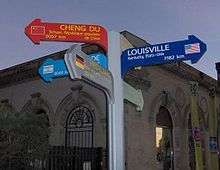
Twin towns – sister cities
Montpellier is twinned with:[19]










.svg.png)


Notable people
Montpellier was the birthplace of:
- Abraham ben Isaac of Narbonne (c. 1110–1179), rabbi and author of the halakhic work Ha-Eshkol
- Nicholas of Poland (c.1235-c.1316), Dominican healer
- Saint Roch (1295–1327), pilgrim to Rome, venerated as a saint by the Roman Catholic Church
- Pierre Magnol (1638–1715), botanist, founder of the concept of plant families
- Étienne-Hyacinthe de Ratte (1722–1805), mathematician and astronomer
- Cyrille Rigaud (1750–1824), poet
- Jean Jacques Régis de Cambacérès (1753–1824), lawyer and statesman, author of the Code Napoléon
- Guillaume Mathieu, comte Dumas (1753–1837), military leader
- Louis-Sébastien Lenormand (1757–1837), chemist, physicist, inventor and the first modern parachuting pioneer in the world
- Auguste Comte (1798–1857), a founder of the discipline of sociology
- Antoine Jérôme Balard (1802–1876), chemist
- Émile Saisset (1814–1863), philosopher
- Charles Bernard Renouvier (1815–1903), philosopher
- Édouard Albert Roche (1820–1883), astronomer
- Alfred Bruyas (1821–1876), art collector
- Alexandre Cabanel (1823–1889), painter
- Renaud de Vilbac (1829–1884), composer, organist
- Frédéric Bazille (1841–1870), Impressionist painter
- Henri-Charles Puech (1902–1986), historian of religion
- Léo Malet (1909–1996), crime novelist
- Henri Carol (1910–1984), French composer and organist
- Jeanne Demessieux (1921–1968), organist, pianist, composer, and pedagogue
- Monique de Bissy, member of the Resistance during World War II (1923–2009)
- Jean-Luc Dehaene (1940–2014), Prime-Minister of Belgium
- Didier Auriol (born 1958), rally driver, 1994 World Rally Champion
- Rémi Gaillard (born 1975), famous French prankster
- Sophie Divry (born 1979), writer, winner of the 2014 Prix Wepler
- Suzanne Verdier (1745–1813), writer
Other famous inhabitants include:
- François Rabelais (1493–1553), student at the University of Montpellier
- Nostradamus (1503–1566), student at the University of Montpellier
- Ioan Iacob Heraclid, ruler of Moldavia from 1561 to 1563
- Pierre-Joseph Amoreux (1741–1824), zoologist
- Jean-Louis Michel (1785–1865), fencing master, who lived in Montpellier from 1830 onwards
- Agénor Azéma de Montgravier (1805–1863), deputy director of l'Ecole d'Artillerie de Montpellier, died in Montpellier in 1863
- Gaston Darboux (1842–1917), mathematician
- Josias Braun-Blanquet (1884–1980), botanist
- Jean Moulin (1899–1943), famous French resistant during WWII, studied and worked in Montpellier
- Alexander Grothendieck (1928–2014), mathematician
- Nikola Karabatić (born 1984), handball player
- Paul Valéry (1871–1945), student at the University of Montpellier
- Enver Hoxha (1908–1985), student at the University of Montpellier
- Grégory Vignal (born 1981), Birmingham City F.C. full-back
- Taha Hussein (1889–1973), student at the University of Montpellier
- Michel Navratil (1908–2001), survivor of the sinking of the RMS Titanic
- Guy Delisle (born 1966), Canadian-born cartoonist, animator and author[20]
- Adamantios Korais (1748–1833), Greek humanist scholar and a major figure in the Greek Enlightenment, studied at the University of Montpellier
Other locations named after Montpellier
"Montpellier" is used as the name of other towns and streets in as many as four continents.[21] Many places in England, Scotland, Wales and Ireland carry the name Montpellier. Often they are in resort locations claiming some of the healthy attributes for which the French city was renowned in earlier centuries. The variant spelling "Montpelier" is common, and is of quite early provenance. Brewer uses that spelling. The first example was the early 19th-century suburb of Montpelier in Brighton.[22]
The capital of the American state of Vermont was named Montpelier because of the high regard in which the Americans held the French[23] who had aided their Revolutionary War against the British. Several other American cities are also named Montpelier.
Places named Montpellier/Montpelier are also found in Australia, Canada, South Africa, and the Caribbean.
References
Citations
- "Populations légales 2017". INSEE. Retrieved 6 January 2020.
- "Archived copy". Archived from the original on 17 April 2017. Retrieved 2 June 2016.CS1 maint: archived copy as title (link)
- Wells, John C. (2008). Longman Pronunciation Dictionary (3rd ed.). Longman. ISBN 978-1-4058-8118-0.
- "Montpellier Tourist Information and Montpellier Tourism". Montpellier Information and Tourism. Retrieved 5 June 2010.
- "Universities in Montpellier and study in Montpellier – International Student Regional Guide". Retrieved 29 January 2015.
- "Montpellier History Facts and Timeline: Montpellier, Languedoc-Roussillon, France". world-guides.com. Retrieved 5 October 2018.
- Hoad, Phil (13 March 2017). "Montpellier in the spotlight: development mania in France's fastest-growing city". The Guardian. Retrieved 5 October 2018.
- "Climatological Information for Montpellier, France". Meteo France. 7 August 2019.
- "MONTPELLIER–AEROPORT (34)" (PDF). Fiche Climatologique: Statistiques 1981–2010 et records (in French). Meteo France. Retrieved 7 August 2019.
- "Normes et records 1961–1990: Montpellier-Frejorgues (34) – altitude 3m" (in French). Infoclimat. Archived from the original on 15 March 2016. Retrieved 7 August 2019.
- INSEE. "Aire urbaine de Montpellier (015)". Insee.fr. Retrieved 21 July 2020.
- Cougnenc, Rémy. "L'université de Montpellier à l'épreuve de la fusion – Journal La Marseillaise". Lamarseillaise.fr. Retrieved 7 September 2018.
- "Railway Gazette: Southern LGV projects make progress". Railwaygazette.com. Retrieved 14 February 2011.
- "Vivre > Transport > Tramway" [Living > Transport > Tramway]. Montpellier-agglo.com (in French). Retrieved 26 December 2014.
- Midi Libre Archived 13 June 2009 at the Wayback Machine (a major daily newspaper in the South of France): "In 2008, 76,000 stations, used 800,000 times, have been registered in Montpellier. A success, and little vandalism compared to the Velib in Paris."
- Tous à Vélo Archived 12 September 2015 at the Wayback Machine AFP 19 October 2007: "Paris, Orléans and Montpellier receive the 'Bicycle Trophy 2007' for their achievement in Bike Sharing programs".
- "Rugby League Montpellier XIII - LES DIABLES ROUGES". Archived from the original on 3 November 2008.
- "Cinemed: Montpellier International Festival of Mediterranean Film – Montpellier Tourist Office". Montpellier-france.com. Retrieved 7 September 2018.
- "Jumelages". montpellier.fr (in French). Montpellier. Retrieved 15 November 2019.
- France3 and AFP (31 January 2015). "Le dessinateur montpelliérain Guy Delisle va passer du cocon familial à la Tchétchénie". France3. Retrieved 14 May 2015.
- "All the Montpelliers". 2005.
- "Montpelier & Clifton Hill Conservation Area Character Statement" (PDF). Brighton & Hove City Council (Design & Conservation Department). 20 October 2005. p. 1. Archived (PDF) from the original on 19 August 2014. Retrieved 31 July 2013.
- Swift, Esther Munroe (1977). Vermont Place Names: Footprints of History. Houghton Mifflin. pp. 451–454. ISBN 0-8289-0291-7.
Sources
- Lewis, Archibald (1971). The Guillems of Montpellier: A Sociological Appraisal.
Further reading
- "Montpellier", A handbook for travellers in France, London: John Murray, 1861, OL 24627024M
- "Montpellier". South-eastern France (3rd ed.). Leipsic: Karl Baedeker. 1898.
- "Montpellier", The Encyclopaedia Britannica, Encyclopædia Britannica (11th ed.), New York, 1910, OCLC 14782424
External links
| Wikivoyage has a travel guide for Montpellier. |
| Wikimedia Commons has media related to Montpellier. |
